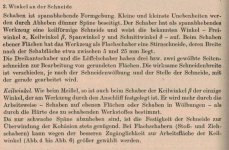The rule is there is no rule

I guess more actually there are too many variables for there to be a rule. It is nice to hear from a professional at least.
There is very little information on pull scraping available in English and from what I can find in German. Does anyone know of any books etc on the topic?
I was taught it - and "carding" - by a Schwabian who had learnt it at Daimler. Around 1900 and a bit, was a master of it War One and right after.
Not sure Herr Pelz was even a full five feet tall?
IF here are books, they might have been written in countries where the "Mechanics" as they called themselves in that era were sharp of mind, but physically SMALL men. The bigger, stronger guys were blacksmiths, farriers, farmers, miners, teamsters/draymen, stevedores, masons, sawyers, and Ironworkers!
Machine-tools were already recognized as "force multipliers" where brain counted more than brawn. Fine fits were still "new technology", needed finesse and
smarts, not a "BFH" and hand-forged HCS chisels.

The reason for "pull" becomes apparent when you have tried both "push" and "pull" and recognize that they had large areas to cover by HAND and had to remain mentally alert and muscle repetition sharp a full ten sweaty hours in, paced as if to music, not be worn-out and making mistakes.
Carbide will pay-off. Stick with it.
Yah just need to develop the auto-muscle finesse to the cyclic touch to not "impact" that edge, each stroke.





 I guess more actually there are too many variables for there to be a rule. It is nice to hear from a professional at least.
I guess more actually there are too many variables for there to be a rule. It is nice to hear from a professional at least.



